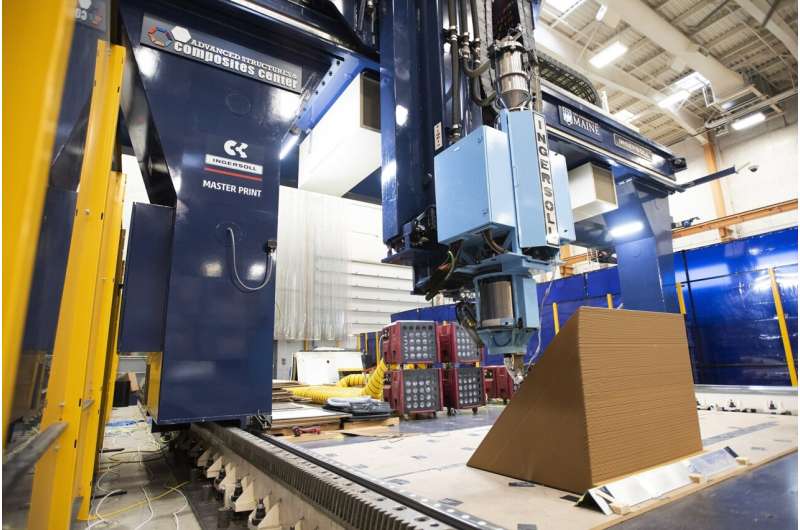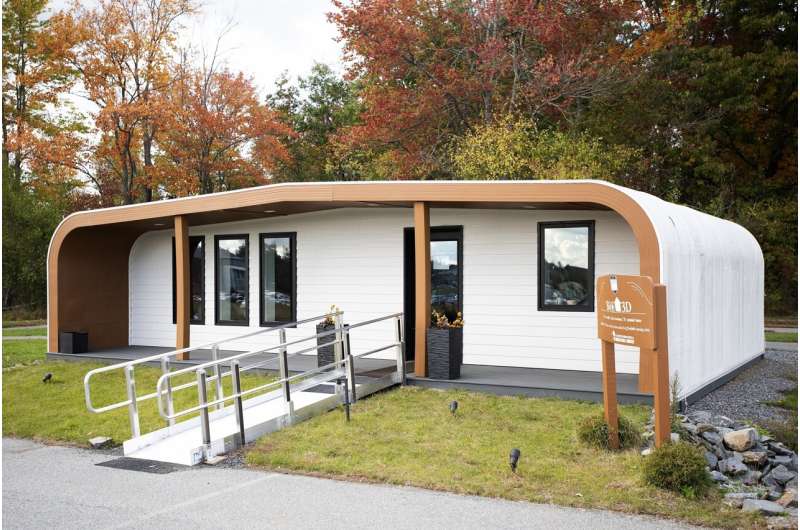
The world's largest 3D printer has created a house that can cut construction time and labor. An even larger printer unveiled on Tuesday may one day create entire neighborhoods.
The machine revealed Tuesday at the University of Maine is four times larger than the first one—commissioned less than five years ago—and capable of printing ever mightier objects. That includes scaling up its 3D-printed home technology using bio-based materials to eventually demonstrate how printed neighborhoods can offer an avenue to affordable housing to address homelessness in the region.
Thermoplastic polymers are extruded from a printer dubbed the "Factory of the Future 1.0." There could be even larger printers after the University of Maine breaks ground this summer on a new building, a spokesperson said.
The massive printer "opens up new research frontiers to integrate these collaborative robotics operations at a very large scale with new sensors, high-performance computing and artificial intelligence," said Habib Dagher, director of UMaine's Advanced Structures & Composite Center, where both of the printers are located.
Those attending the event included representatives from departments of defense, energy and housing, as well as other stakeholders who plan to utilize the new technologies made available by the printer. Heidi Shyu, under secretary of defense for research and engineering, said the printer "stands as a beacon of innovation."

The printer's frame fills up the large building in which it's housed on the UMaine campus, and can print objects 96 feet long by 32 feet wide by 18 feet high (29 meters by 10 meters by 5.5 meters).
It has a voracious appetite, consuming as much as 500 pounds (227 kilograms) of material per hour.
The original printer, christened in 2019, was certified by Guinness World Records as the world's largest polymer 3D printer, the university said. It was used to create a 600-square-foot, single-family home made of wood fiber and bio-resin materials that are recyclable. Dubbed "BioHome3D," it showed an ability to quickly produce homes. To meet the growing demand for housing, Maine alone will need another 80,000 homes over the next six years, according to MaineHousing.
Dagher said there's a shortage of both affordable housing and workers to build homes. The university wants to show how homes can be constructed nearly entirely by a printer with a lower carbon footprint. The buildings and construction sector accounts for roughly 37% of global greenhouse gas emissions, largely due to the production and use of materials such as cement, steel and aluminum that have a significant carbon footprint, according to the United Nations Environment Programme.

Such printed buildings can be recycled, which is unique compared to current construction. "You can basically deconstruct it, you can grind it up if you wish, the 3D printed parts, and reprint with them, do it again," Dagher said before the event.
"It's not about building a cheap house or a biohome," he added, referring to the first 3D-printed house made entirely with bio-based materials. "We wanted to build a house that people would say, 'Wow, I really want to live there.'"
Looking ahead, researchers plan to tinker with the material consumed by the machine, including more bio-based feedstocks from wood residuals that are abundant in Maine, the nation's most heavily forested state.
But it can be used for a variety of other creations and already has been used for a range of things, from boats to defense department structures. In the past, the university showed off a 25-foot boat created by the first printer.

As for the original 3D printer, it isn't going away. The two printers can be used in concert to streamline manufacturing by working on the same project—or even part if necessary—and there will be even more of them working together in the future, officials said.
© 2024 The Associated Press. All rights reserved. This material may not be published, broadcast, rewritten or redistributed without permission.
Citation: The world's largest 3D printer is at a university in Maine. It just unveiled an even bigger one (2024, April 23) retrieved 23 April 2024 from https://techxplore.com/news/2024-04-world-largest-3d-printer-university.html
This document is subject to copyright. Apart from any fair dealing for the purpose of private study or research, no part may be reproduced without the written permission. The content is provided for information purposes only.
